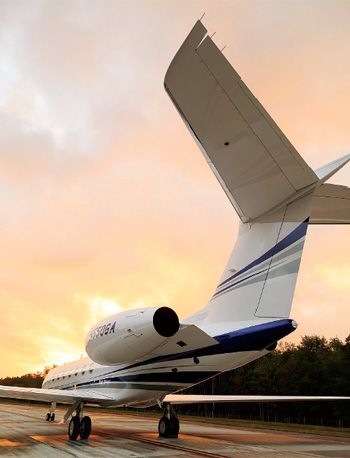INDIAN ARMED FORCES CHIEFS ON
OUR RELENTLESS AND FOCUSED PUBLISHING EFFORTS

SP Guide Publications puts forth a well compiled articulation of issues, pursuits and accomplishments of the Indian Army, over the years

I am confident that SP Guide Publications would continue to inform, inspire and influence.

My compliments to SP Guide Publications for informative and credible reportage on contemporary aerospace issues over the past six decades.
Crisis Looms Large
The economic downturn is expected to have a telling effect on business aviation and airframers are worried about the cascading effect it will have on global markets

The International Monetary Fund (IMF) has cautioned that there could be a global recession following the economic crisis that is gripping China at the moment. This concern comes in the wake of an economic slowdown in China, even while the Chinese Government is making efforts on various fronts, including strategically shifting its economy which is dependent on manufacturing to one that spurs domestic consumption. As financial links of China is fast spreading across global markets, the impact on global economies is going to be real. “China’s financial integration with the rest of the world is expected to accelerate, and its financial influence abroad will likely catch up with its economic prowess” the IMF said.
IMF said that China has to have a “clear and timely communication of its policy decisions, transparency about its policy goals, and strategies consistent with achieving them will, therefore, be essential to ensure against volatile market reactions, which may have broader repercussions.” The Chinese Government lowered its official 2016 growth target down to ‘around 6.5 per cent’ from around 7 per cent in 2015. The scenario could be worse.
Business Aviation to be Hit
Obviously this is going to impact the aviation industry, more so business aviation which is still in its early stages of development. The economic downturn is expected to have a telling effect on business aviation and airframers are worried about the cascading effect it will have on global markets. Though the long-term predictions remain that the Chinese aviation market will overtake the US market to take the number one spot, presently China is struggling.
The business aviation segment is banking on China to recover as the airframers believe that the country will be the ‘future of business aviation’ considering its geographical expanse as well as its economic capabilities. After the 2008 recession, China sprang to its feet fast and growth had been impressive. The annual growth projections were close to 20 per cent and aviation analysts said China would lead the way. That has taken a temporary hit.
CHINA VERSUS INDIA

When it comes to business aviation, India and China have both seen a see saw growth.
Currently we are seeing an anti-graft induced slowdown for BA in China, of course coupled with general slowdown in their economy as well. The signs for future are perhaps not that positive.
When it comes to India, despite a more open and faster growing economy, our BA growth is stagnating. However, the potential for sharp growth is tremendous in India. The signs are all positive.
— Jayant Nadkarni, President, BAOA

Flexibility is a big issue while operating in Chinese airspace due to military control over the complete national territory. Growth of business aviation would remain largely limited to big cities in China due to lack of focus on remote/regional connectivity. In India, on the other hand, inflexible regulatory regime and differential taxation on different types of operation (private business flying and corporate flying) is a major stumbling block to growth of business aviation.
— Group Captain Rajesh K. Bali (Retd), Managing Director, BAOA

China definitely has a bigger Business Aviation market than India. It wasn’t so a few years ago, but opened up once the Chinese government opened up the airspace to civil aviation and made acquisition and operations easier. Infrastructure was never a problem in China, as it is in India. The rules were eased, and China saw the induction of more than 200 business jets in the past 4-5 years. While it has slowed down a bit now due to the slowing Chinese economy, it is still growing at a faster rate than India.
— Rohit Kapur, Managing Director, Arrow Aircraft Sales & Charters (Former President, BAOA)
The nascent business aviation industry was just about moving along when the crisis started coming all over again. One may recall that in China private ownership of aircraft was illegal till about 2003, but subsequently the Chinese authorities realised that it was a business tool and the growth was quite impressive, registering double-digit rates through the last five years. Now it has slowed down.
The projections by certain market analysts was that China would have about 950 private aircraft sales between 2014 and 2023, and post that till 2033, it would notch up another 1,275 business aircraft. There are doubts now that these numbers may not be achieved and a correction would take place soon.
Declining Markets
Growth hit only 15.5 per cent in 2014, according to a report by the Asian Sky Group consultancy, released in mid-April last. “I don’t think anybody’s been spared,” said Jeffrey Lowe, Managing Director, Asian Sky Group. “If you look at all the other high-end commodities that have been impacted as far as China sales, it’s certainly not surprising that business jets are feeling the crimp.”
IF ONE HAS TO LOOK AT LONG HAUL, THEN THE BUSINESS AVIATION SECTOR IS EXPECTED TO RISE LIKE THE PHOENIX. ONE OF THE AIRFRAMERS IS CONFIDENT THAT THE SECTOR WILL REGAIN MOMENTUM IN THE NEXT FEW YEARS
Asian Sky’s report said the combined markets of China, Hong Kong, Macau and Taiwan were “very much in decline.” The net number of aircraft added to the combined fleets was more than 100 in 2012, falling to 64 in 2013 and 59 in 2014. It is estimated that China’s large charter companies have had a 40 per cent drop-off in business since President Xi Jinping began his austerity campaign after assuming power in late 2012.
“Charters have gone away, just like gift-giving and banquets,” he said, noting that for most large Chinese charter operators, the central government had been one of the biggest sources of business. Similarly, the banks which were patronising business aviation have gone missing. Many of China’s stateowned banks — including the Industrial and Commercial Bank of China, the Agricultural Bank of China and the China Development Bank — had entered the business-jet leasing market following the lead of Minsheng, which placed its first order in July 2010. Now many of those banks are looking to sell underused aircraft, creating sales competition for manufacturers like Gulfstream, Bombardier and Dassault Falcon. But even without external pressures, the business-jet market may simply be hitting its natural level.
Gulfstream remains the most popular aircraft manufacturer in China, accounting for nearly one-third of business jets market in China. Looking ahead, the company remains “optimistic” on the Chinese market.

Honeywell Predicts Lower Figures
Honeywell’s Global Business Aviation Forecast for 2015 has said the growth figures could be lower and government austerity initiatives would result in further decline in sales. Accordingly, the total share of the global demand over next five years for Asia Pacific – with China as its hub — is only about three per cent, a downsizing from five per cent predicted in 2013. The reasons are all obvious, beginning with the economic slowdown. Besides that the business aviation segment is strapped because of the government policies – most important being – airspace is controlled by the Chinese Air Force which restricts movement of business aircraft. Business aviation operators have to run from pillar to post to get approvals, for charter or for any aircraft movement. Being a communist country, the business aviation segment is still seen as private wealth creation, despite efforts from various industry associations pointing out that business aircraft are effectively for business purposes, considering the distances in China and air connectivity.
According to a white paper the key reasons for a slowing of the growth in Chinese business aviation, included that the real estate and heavy industry, like steel production, have contributed to a slowing of the national economy. There is no off-take for housing projects and television programmes have been pointing out several ‘ghost’ towns in China where huge housing complexes have no takers. So one can imagine the fate of business aviation segment and making matters worse is that there are quite a number of private jets up for sale. According to a report by Corporate Jet Investor, second-hand sales have touched 10.2 per cent, a not too healthy sign.
If one has to look at long haul, then the business aviation sector is expected to rise like the Phoenix. One of the airframers is confident that the sector will regain momentum in the next few years. The Canadian aircraft maker, Bombardier is still holding on to its prediction that China will have a seven-fold increase of business jets between 2012 and 2032. The forecast also predicts that China will account for nearly 10 per cent of the worldwide business jet fleet in 2032. This compares to less than two per cent in 2012. Most believe that it is cyclical and that there would be a strong recovery and continued economic growth within the country for the next decade.
According to Bombardier, greater China had four aircraft for every $100 billion of gross domestic product in 2013, compared with 23 in Africa, 42 in Latin America and 69 in North America. Bombardier is projecting 11 per cent compound annual growth for aircraft delivery to greater China through 2023. And if it is any consolation, China is not the only market that has slowed recently; Russian and Latin American demand has decreased as well.





